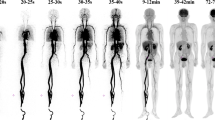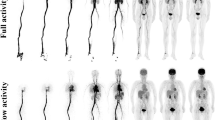Abstract
Purpose
At 18F-2-fluoro-2-deoxy-D-glucose (FDG) positron emission tomography (PET) examinations a high tracer uptake of the skeletal muscles is sometimes encountered which can lead to reduced uptake in pathological lesions. This was evaluated in retrospect in patients being recalled for a repeat examination after reducing the muscular uptake.
Methods
Ten patients with increased muscular tracer uptake were examined with FDG PET/CT on two occasions with a mean of 6 days. All patients showed at least one pathological lesion with increased tracer uptake. The muscular uptake was reduced at the second examination by informing the patient to refrain from physical activity together with pretreatment with diazepam. The maximum standardized uptake value (SUVmax) of the pathological lesion and SUVmean of certain skeletal muscles, liver, spleen, lungs, blood and certain bone marrow portions were calculated.
Results
In all patients, the muscular uptake was reduced to a normal level at visual evaluation as well as at comparison of SUVs with 25 consecutive clinical patients exhibiting a normal FDG distribution (p < 0.001). The mean lesion SUVmax increased from 2.4 to 3.7 (54 %) between the examinations (p < 0.05). All reference tissues/organs showed a significant increase of SUV at the second examination. Relating lesion SUVmax to the activity of any of the reference tissues/organs there was no significant difference between the studies.
Conclusion
The distribution of FDG constitutes a relative mechanism. This must be especially considered at longitudinal examinations in the same patient at therapy evaluations. In examinations with a somehow distorted general distribution of the activity, it may be more relevant to relate the lesion activity to a reference tissue/organ than relying on SUV assessments.


Similar content being viewed by others
References
Boellaard R. Standards for PET image acquisition and quantitative data analysis. J Nucl Med 2009;50(Suppl):11S–20S.
Chander S, Ergun EL, Zak IT, Zingas AP, Bloom DA, Joyrich RN, et al. Diaphragmatic and crural FDG uptake in hyperventilating patients: a rare pattern important to recognize. Clin Nucl Med 2004;29:296–9.
Boellaard R, Oyen WJG, Hoekstra CJ, Hoekstra OS, Visser EP, Willemsen AT, et al. The Netherlands protocol for standardisation and quantification of FDG whole body PET studies in multi-centre trials. Eur J Nucl Med Mol Imaging 2008;35:2320–33.
Vriens D, Visser EP, de Geus-Oei L-F, Oyen WJG. Methodological considerations in quantification of oncological FDG PET studies. Eur J Nucl Med Mol Imaging 2010;37:1408–25.
Wahl RL, Jacene H, Kasamon Y, Lodge MA. From RECIST to PERCIST: evolving considerations for PET response criteria in solid tumors. J Nucl Med 2009;50(Suppl):122S–50S.
Boellaard R. Need for standardization of 18F-FDG PET/CT for treatment response assessments. J Nucl Med 2011;52(Suppl):93S–100S.
Minn H, Zasadny KR, Quint LE, Wahl RL. Lung cancer: reproducibility of quantitative measurements for evaluating 2-[F-18]-fluoro-2-deoxy-D-glucose uptake at PET. Radiology 1995;196:167–73.
Weber WA, Ziegler SI, Thödtmann R, Hanauske A-R, Schwaiger M. Reproducibility of metabolic measurements in malignant tumors using FDG PET. J Nucl Med 1999;40:1771–7.
Nakamoto Y, Zasadny KR, Minn H, Wahl RL. Reproducibility of common semi-quantitative parameters for evaluating lung cancer glucose metabolism with positron emission tomography using 2-deoxy-2-[18F]fluoro-D-glucose. Mol Imaging Biol 2002;4:171–8.
Krak NC, Boellaard R, Hoekstra OS, Twisk JW, Hoekstra CJ, Lammertsma AA. Effects of ROI definition and reconstruction method on quantitative outcome and applicability in a response monitoring trial. Eur J Nucl Med Mol Imaging 2005;32:294–301.
Nahmias C, Wahl LM. Reproducibility of standardized uptake value measurements determined by 18F-FDG PET in malignant tumors. J Nucl Med 2008;49:1804–8.
Kanstrup I-L, Klausen TL, Bojsen-Møller J, Magnusson P, Zerahn B. Variability and reproducibility of hepatic FDG uptake measured as SUV as well as tissue-to-blood background ratio using positron emission tomography in healthy humans. Clin Physiol Funct Imaging 2008;29:108–13.
Velasquez LM, Boellaard R, Kollia G, Hayes W, Hoekstra OS, Lammertsma AA, et al. Repeatability of 18F-FDG PET in a multicenter phase I study of patients with advanced gastrointestinal malignancies. J Nucl Med 2009;50:1646–54.
Frings V, de Langen AJ, Smit EF, van Velden FH, Hoekstra OS, van Tinteren H, et al. Repeatability of metabolically active volume measurements with 18F-FDG and 18F-FLT PET in non-small cell lung cancer. J Nucl Med 2010;51:1870–7.
Thomas BA, Erlandsson K, Modat M, Thurfjell L, Vandenberghe R, Ourselin S, et al. The importance of appropriate partial volume correction for PET quantification in Alzheimers’s disease. Eur J Nucl Med Mol Imaging 2011;38:1104–19.
Keyes Jr JW. SUV: standard uptake or silly useless value? J Nucl Med 1995;36:1836–9.
Adams MC, Turkington TG, Wilson JM, Wong TZ. A systematic review of the factors affecting accuracy of SUV measurements. AJR Am J Roentgenol 2010;195:310–20.
Jacene HA, Ishimori T, Engles JM, Leboulleux S, Stearns V, Wahl RL. Effects of pegfilgrastim on normal biodistribution of 18F-FDG: preclinical and clinical studies. J Nucl Med 2006;47:950–6.
Doot RK, Dunnwald LK, Schubert EK, Muzi M, Peterson LM, Kinahan PE, et al. Dynamic and static approaches to quantifying 18F-FDG uptake for measuring cancer response to therapy, including the effect of granulocyte CSF. J Nucl Med 2007;48:920–5.
Teo B-K, Badiee S, Hadi M, Lam T, Johnson L, Seo Y, et al. Correcting tumour SUV for enhanced bone marrow uptake: retrospective 18F-FDG PET/CT studies. Nucl Med Commun 2008;29:359–66.
Acknowledgments
The authors wish to thank Elisabeth Berg, B.Sc., Karolinska Institutet, for the statistical analysis.
Conflicts of interest
None.
Author information
Authors and Affiliations
Corresponding author
Rights and permissions
About this article
Cite this article
Lindholm, H., Johansson, O., Jonsson, C. et al. The distribution of FDG at PET examinations constitutes a relative mechanism: significant effects at activity quantification in patients with a high muscular uptake. Eur J Nucl Med Mol Imaging 39, 1685–1690 (2012). https://doi.org/10.1007/s00259-012-2202-0
Received:
Accepted:
Published:
Issue Date:
DOI: https://doi.org/10.1007/s00259-012-2202-0




